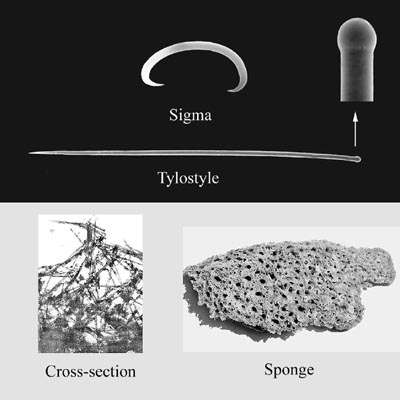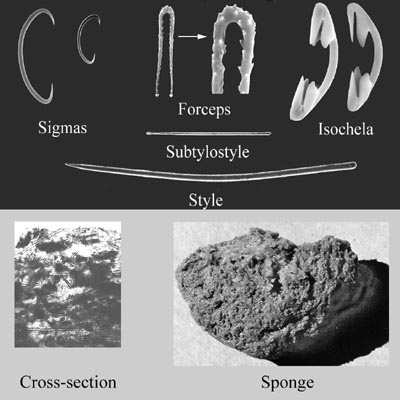[A]
Microscleres are Sigmas ONLY.
Megascleres are Subtylostyles to Tylostyles. |
 (Schmidt, 1870)
(Schmidt, 1870) |
Sponge:
Amorphous, fragile.
Color: Alive: Drab.
Spicules: Megascleres:
(1) Subtylostyles to Tylostyles:
255 - 308-372- 1006 um.
x 15 um.
Microscleres:
(1) Sigmas:
13 -23-61- 72 um.
Skeleton:
Thin, detachable, fleshy dermis with a few microscleres.
Choanosome of short plumose columns of megascleres with points toward the surface.
Distribution: Southern, central California.
Depth: Deep water, 700 to 1243 m.
Note: De Laubenfels originally decribed this species as occurring in California on the basis of one small piece of a specimen. Review of more recently collected material suggests that there may be more than a single species of Desmacella from California. In addition, the status of the legitimacy of D.vagabunda is in question. These species need much more extensive review. Note also that de Laubenfels give the size of Tylostyles as "about 15 μm x 600 μm." Other specimens observed have lengths to 1006 μm.
|
|
[B]
Microscleres include Palmate Isochelae, Sigmas, and Forceps.
Megascleres are Styles.
|
 (de Laubenfels, 1930)
(de Laubenfels, 1930) |
Sponge:
The spicule measurments given here are those originally given by de Laubenfels, 1935. See note below.
Spicules: Megascleres:
(1)Styles:
330 - 600 um.
x 10 - 15 um.
Microscleres:
(1)Palmate Anisochelae:
17-20 um.
(2)Sigmas:
55-75 um.
(3)Sigmas:
250 um.
(4)Forceps:
10 -12 um.
Note: This species was described by de Laubenfels as Wilsa hymena on the basis of a single, incomplete, and contaminated specimen growing on a hexactinellid sponge. As such, its identity as Wilsa would remain in doubt, based on the type. However, an uncontaminated specimen which matches most of the original description has been discovered and described. The species is now known as Forcepia hymena. See page 151B for details. Cf. Lee, 2001.
|
|